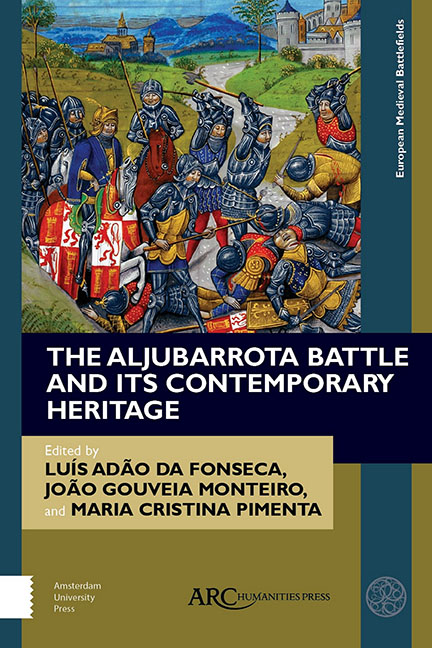Book contents
- Frontmatter
- Contents
- List of Illustrations
- Introduction
- Chapter 1 Before Aljubarrota
- Chapter 2 Fighting a Battle in the Middle Ages
- Chapter 3 The Decision to Fight at Aljubarrota
- Chapter 4 The Decisive Battle
- Chapter 5 Casualties and the Aftermath
- Chapter 6 Contemporary Memory and Myth-Making
- Chapter 7 The Legacy for Later Memories
- Chapter 8 The Battle of Aljubarrota Interpretation Centres
- Select Bibliography
- Index
Chapter 6 - Contemporary Memory and Myth-Making
Published online by Cambridge University Press: 20 November 2020
- Frontmatter
- Contents
- List of Illustrations
- Introduction
- Chapter 1 Before Aljubarrota
- Chapter 2 Fighting a Battle in the Middle Ages
- Chapter 3 The Decision to Fight at Aljubarrota
- Chapter 4 The Decisive Battle
- Chapter 5 Casualties and the Aftermath
- Chapter 6 Contemporary Memory and Myth-Making
- Chapter 7 The Legacy for Later Memories
- Chapter 8 The Battle of Aljubarrota Interpretation Centres
- Select Bibliography
- Index
Summary
THE MILITARY VICTORY of the King of Portugal at Aljubarrota can now be revisited through examining his legacy as an expression of a historical memory inseparable from the identity of the Portuguese people. And because it is a memory, it lies within a multiplicity of facets which force us to view different aspects of a past that has become mythical. Indeed, we must go further, beyond the military event itself and link it with a concerted policy of idolization of the Avis dynasty involving the figures of the monarch João I himself and his Constable, Nuno Álvares Pereira. This is not a “memory with no faces.” In this regard, it is worth remembering the sound words of Annarita Gori when she wrote:
The epic period which forms the basis of the Portuguese idea of saudade is not only that of the Age of the Discoveries, but is chosen for the importance and force it had for the redemption of the Portuguese Nation. As such, alongside the characters connected with the maritime expansion of Portugal such as Vasco da Gama or Afonso de Albuquerque, we can also find those leading the battles for the conquest, independence, and restoration of Portugal, amongst which are the hero of the battle at Ourique, King Afonso Henriques, and the Holy Constable Nun’Álvares Pereira, the leader of the Battle of Aljubarrota.
The Avis Dynasty, through a broad programme of action, carried out a veritable refounding of the kingdom, based on three pillars built in the space of two short years (1385–1386). The institutional pillar was put in place at the Cortes of Coimbra by the election of the Master of Avis as King of Portugal (April 1385), the military pillar was formed by the victory at the Battle of Aljubarrota (August 1385), and the diplomatic pillar was made possible by the signing of the Portuguese-English alliance in Windsor (May 1386). The aim of this chapter is to look more deeply at the legacy of the military dimension, based on the sources at our disposal: texts produced during the Middle Ages and preserved in later narratives—at which point they sometimes took on an even more exalted and pronounced translation.
- Type
- Chapter
- Information
- Aljubarrota Battle and Its Contemporary Heritage , pp. 75 - 90Publisher: Amsterdam University PressPrint publication year: 2020



